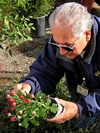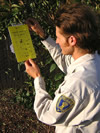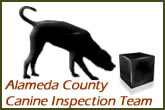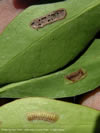Pest Exclusion
Glassy-winged Sharpshooter (GWSS)

Inspecting incoming nursery stock for Glassy-winged Sharpshooter

Surveying for Glassy-winged Sharpshooter

Inspecting a trap
for Glassy-winged
Sharpshooter
The Glassy-winged Sharpshooter (GWSS) is a serious pest of grapes that poses a significant threat to California's $2.65 billion grape industry. Additionally, this pest can spread several other serious diseases to almond, alfalfa, citrus, and some ornamental plants, all important crops in California.
GWSS is native to the southeast United States and is also found in Mexico. It was first identified in California in 1990 and is now found throughout Southern California and parts of Kern and Tulare Counties. GWSS feeds on grape vines with specialized mouth parts that allow it to pierce the woody stems. Through feeding, the GWSS spreads the bacterium that causes Pierce's Disease, which is fatal to grapevines. There is currently no treatment or cure for this disease.
In 1995, large numbers of wine grapevines began to die in Temecula, Riverside County, after being infected with Pierce's Disease by GWSS. Since that time, a quarantine has been established which regulates the movement of host plants for this pest from infested areas of California to non-infested areas of the State in an attempt to limit its spread. The GWSS feeds on a wide variety of ornamental and crop plants and can be easily transported on nursery stock from infested areas of California as egg masses, nymphs or adults. Plants must be inspected at both origin and destination to make sure they are free from all life stages of GWSS.
APPEARANCE:
GWSS adults are approximately ½ inch long and are dark brown to blackish in color, with some white on the underside of the body. The upper parts of the head and back are stippled with ivory or yellowish spots and the wings are partly transparent with reddish veins. The eyes and "snout" are very prominent. It essentially looks like a very large leaf hopper. Nymphs are just smaller versions of the adult and lack the white color until they are nearly mature.
The egg masses are found on the underside of leaves and vary in size from about ½ to 1 inch in length. They are laid in a straight line or may be slightly curved in appearance. Very freshly laid egg masses look like a blister in the leaf tissue and are the same color as the leaf they are laid in; old egg masses turn a light brown color. The number of eggs in each mass can vary from 10-20 eggs. There can be numerous egg masses on one plant.
DETECTION:
Early detection of this pest is essential in preventing additional damage to susceptible crops and endangering our export markets. Detection traps are placed throughout the county in nurseries, newly landscaped sites and residential areas in order to detect any GWSS that may be transported into the county from infested areas. We may ask your permission to place a yellow sticky trap in a tree on your property for several weeks as part of our detection effort. For more information on our Pest Detection program, please call (510) 670-5156 or visit the Pest Detection section of this website.
You can help prevent the spread of this pest by contacting our office should you see an insect that looks like GWSS or find suspect egg masses on your plants. Purchase your nursery stock from licensed nurseries and do not transport any plants directly from Southern California without proper certification.

 Community Development Agency
Community Development Agency AGRICULTURE PROGRAMS
AGRICULTURE PROGRAMS


